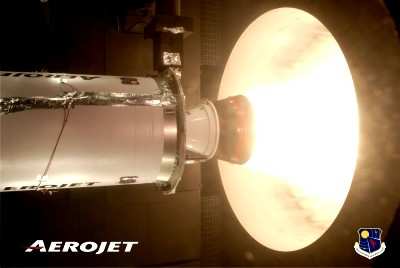Fri, Oct 09, 2009
Aerojet Developing New ICBM Motors Through An Air Force
Contract
 Aerojet and the U.S. Air Force successfully conducted a
full-scale, full-duration static test of Aerojet's Advanced Second
Stage (A2S) motor, reporting that all test objectives were fully
achieved.
Aerojet and the U.S. Air Force successfully conducted a
full-scale, full-duration static test of Aerojet's Advanced Second
Stage (A2S) motor, reporting that all test objectives were fully
achieved.
Aerojet developed the large solid propellant rocket motor on the
Propulsion Application Program (PAP) under contract to the 526th
ICBM Systems Group at Hill AFB, Utah. The test was conducted at
simulated altitude conditions, essentially zero atmospheric
pressure, by the Air Force's Arnold Engineering Development Center
in Tullahoma, PA. The purpose was to measure true motor performance
in a flight-like environment. This was the second successful static
test of the A2S motor following a flawless sea-level test at the
Air Force Research Laboratory at Edwards AFB in California in
June.
The PAP program's primary goal is to develop a new generation of
ICBM-sized motors with increased propulsion performance and lower
manufacturing and operational costs. In order to meet these goals,
the A2S design consists of numerous new technologies and
manufacturing materials and processes including a graphite
composite case fabricated with environmentally friendly materials,
a low-cost movable nozzle capable of six degrees of thrust vector
control, Honeywell-supplied electrical-mechanical actuators and
digital controller, and high energy solid propellant developed at
Aerojet's Sacramento, CA facility.
Initial post-test inspection indicates that the motor
performance was excellent and the component design was robust. This
is the final static test of the A2S motor under the PAP program as
the design has been validated under both sea-level and altitude
conditions.

The successful test culminates a multi-year effort that applies
technology pertinent to the sustainment of strategic strike missile
architecture," said Mark Kaufman, executive director of Strategic
Propulsion Programs at Aerojet. "The Propulsion Applications
Program has proven to be a worthwhile initiative for balancing
design, technology and methods of manufacture with overall weapon
system life cycle cost. The A2S can now be added to the Air Force
portfolio of ICBM propulsion options as they weigh alternatives for
the sustainment of strategic strike. The A2S program also provided
an excellent venue for engaging a new generation of propulsion
engineers."
More News
He Attempted To Restart The Engine Three Times. On The Third Restart Attempt, He Noticed That Flames Were Coming Out From The Right Wing Near The Fuel Cap Analysis: The pilot repor>[...]
Make Sure You NEVER Miss A New Story From Aero-News Network Do you ever feel like you never see posts from a certain person or page on Facebook or Instagram? Here’s how you c>[...]
From 2009 (YouTube Edition): Leading Air Show Performers Give Their Best Advice for Newcomers On December 6th through December 9th, the Paris Las Vegas Hotel hosted over 1,500 air >[...]
Aero Linx: NASA ASRS ASRS captures confidential reports, analyzes the resulting aviation safety data, and disseminates vital information to the aviation community. The ASRS is an i>[...]
“For our inaugural Pylon Racing Seminar in Roswell, we were thrilled to certify 60 pilots across our six closed-course pylon race classes. Not only did this year’s PRS >[...]
 NTSB Final Report: Rutan Long-EZ
NTSB Final Report: Rutan Long-EZ ANN FAQ: Turn On Post Notifications
ANN FAQ: Turn On Post Notifications Classic Aero-TV: ICAS Perspectives - Advice for New Air Show Performers
Classic Aero-TV: ICAS Perspectives - Advice for New Air Show Performers ANN's Daily Aero-Linx (06.28.25)
ANN's Daily Aero-Linx (06.28.25) Aero-News: Quote of the Day (06.28.25)
Aero-News: Quote of the Day (06.28.25)



